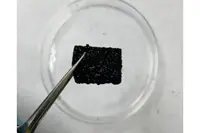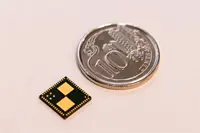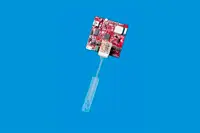Electronics News
Archive : 27 November 2015 год
 A first-of-its-kind self-healing gel that is claimed to repair and connect electronic circuits has been developed by researchers in the Cockrell School of Engineering at The University of Texas. This material could create opportunities to advance the development of flexible electronics, biosensors and batteries as energy storage devices.
A first-of-its-kind self-healing gel that is claimed to repair and connect electronic circuits has been developed by researchers in the Cockrell School of Engineering at The University of Texas. This material could create opportunities to advance the development of flexible electronics, biosensors and batteries as energy storage devices.
Technology is moving toward lighter, flexible, foldable and rollable electronics, but the existing circuits that power them are not built to flex freely and repeatedly self-repair cracks or breaks that can happen from normal wear and tear.
Until now, self-healing materials have relied on application of external stimuli such as light or heat to activate repair. The UT Austin material is said to exhibit high conductivity and strong mechanical and electrical self-healing properties.
Guihua Yu, the mechanical engineering assistant professor who developed the gel, said: "In the last decade, the self-healing concept has been popularised by people working on different applications, but this is the first time it has been done without external stimuli."
Yu and his team created the self-healing gel by combining a self-assembling metal-ligand gel that provides self-healing properties and a polymer hydrogel that acts as a conductor.
Using terpyridine molecules to create the framework and zinc atoms as a structural glue, the molecules form structures that are able to self-assemble, giving it the ability to automatically heal after a break.
When the supramolecular gel is introduced into the polymer hydrogel, forming the hybrid gel, its mechanical strength and elasticity are enhanced.
The researchers used a disc-shaped liquid crystal molecule to enhance the conductivity, biocompatibility and permeability of their polymer hydrogel. They were able to achieve about 10 times the conductivity of other polymer hydrogels used in bioelectronics and conventional rechargeable batteries.
Yu believes the self-healing gel would not replace the typical metal conductors that transport electricity, but it could be used as a soft joint, joining other parts of the circuit.
"This gel can be applied at the circuit's junction points because that's often where you see the breakage," he said. "One day, you could glue or paste the gel to these junctions so that the circuits could be more robust and harder to break."
Yu's team is also looking into other applications, including medical applications and energy storage, where it holds the potential to be used within batteries to better store electrical charge.
Author
Tom Austin-Morgan
Source: www.newelectronics.co.uk
 Scientists from Nanyang Technological University (NTU Singapore), led by Professor Rachid Yazami, have developed a smart chip which can tell you how healthy your battery is and if it is safe for use.
Scientists from Nanyang Technological University (NTU Singapore), led by Professor Rachid Yazami, have developed a smart chip which can tell you how healthy your battery is and if it is safe for use.
Current warning systems only alert users when the battery is already overheating which may be too late for remedial action. Prof Yazami’s chip sends a warning message before a fault or fire occur and is small enough to be embedded in almost all batteries, from the small batteries in mobile devices to the huge power packs found in electric vehicles and advanced aeroplanes.
“Although the risk of a battery failing and catching fire is very low, with the billions of lithium-ion batteries being produced yearly, even a one-in-a-million chance would mean over a thousand failures,” explained Prof Yazami.
“This poses a serious risk for electric vehicles and even in advanced aeroplanes as usually big battery packs have hundreds of cells or more bundled together to power the vehicle or aircraft. If there is a chemical fire caused by a single failed battery, it could cause fires in nearby batteries, leading to an explosion.”
Embedded in the smart chip is a proprietary algorithm developed by Prof Yazami that is based on electrochemical thermodynamics measurements (ETM technology).
Current li-ion batteries have a chip in them which only shows voltage and temperature readings. Today’s battery chips are unable to detect symptoms of a malfunction and can also show only the estimated amount of charge the battery is holding. In comparison, Prof Yazami’s algorithm is able to analyse both the state of health and the state of charge through a 3-dimensional chart.
Prof Yazami continued: “In addition to knowing the degradation of batteries, our technology can also tell the exact state of charge of the battery, and thus optimise the charging so the battery can be maintained in its best condition while being charged faster.”
The smart chip took Prof Yazami more than five years to develop and is now marketed by his start-up, KVI Pte. KVI is developing this chip into a series of products, which include battery packs for recharging mobile devices, charge gauge for electric vehicles, and a smart chip for every battery.
It is expected that the technology will be made available for licensing by chipmakers and battery manufacturers before the end of 2016.
Author
Tom Austin-Morgan
Source: www.newelectronics.co.uk
 Imec and Holst Centre have demonstrated a prototype of a single-chip electrochemical sensor for simultaneous detection of multiple ions in fluids. The demonstrator paves the way to small-sized, low-cost detection systems for agriculture, healthcare and lifestyle applications, food quality monitoring and water management.
Imec and Holst Centre have demonstrated a prototype of a single-chip electrochemical sensor for simultaneous detection of multiple ions in fluids. The demonstrator paves the way to small-sized, low-cost detection systems for agriculture, healthcare and lifestyle applications, food quality monitoring and water management.
The ion sensor solution is a generic platform that can be tailored towards specific applications. It is said to enable efficient and low-cost monitoring, for example: monitoring of nutrient concentrations in surface and waste water, both for agricultural applications and water quality. In the healthcare and lifestyle applications, it provides disposable point-of-care solutions, or conformable solutions for integration into patches.
Depending on the application and the form factor, the device can be mass produced through microfabrication or through screen-printing on inexpensive substrates such as glass or foil.This brings advantages in terms of low cost manufacturability, and size.
The presented prototype is a handheld device that integrates a single-chip sensor with different electrodes that detect pH levels in a range from 2 to 10 at 0.1pH accuracy. For the chemical elements chloride, sodium, potassium, and nitrate the sensor is claimed to detect at 10% accuracy. Benchmarked against other available single-ion sensors, imec’s prototype is said to have demonstrated comparable sensitivity and accuracy for a multiple-ion solution.
“Imec aims to develop the building blocks that enable an Intuitive Internet of Things,” stated Kathleen Phillips, programme director of perceptive systems at imec. “As we continue to improve our sensor platform, develop sensors for other ions, integrate more sensors into a single system, and extend the lifetime of our sensor, imec will be at the nucleus in driving the advancements of smart connected systems.”
Author
Tom Austin-Morgan
Source: www.newelectronics.co.uk

